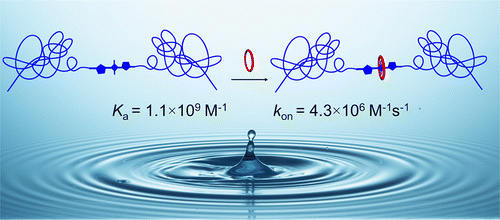
Evan M. Peck, Wenqi Liu, Graeme T. Spence, Scott K. Shaw, Anthony P. Davis*, Harry Destecroix, and Bradley D. Smith *
J. Am. Chem. Soc., 2015, 137, 8668–8671
Abstract
A macrocyclic tetralactam host is threaded by a highly fluorescent squaraine dye that is flanked by two polyethylene glycol (PEG) chains with nanomolar dissociation constants in water. Furthermore, the rates of bimolecular association are very fast with kon ≈ 106–107 M–1 s–1. The association is effective under cell culture conditions and produces large changes in dye optical properties including turn-on near-infrared fluorescence that can be imaged using cell microscopy. Association constants in water are ∼1000 times higher than those in organic solvents and strongly enthalpically favored at 27 °C. The threading rate is hardly affected by the length of the PEG chains that flank the squaraine dye. For example, macrocycle threading by a dye conjugate with two appended PEG2000 chains is only three times slower than threading by a conjugate with triethylene glycol chains that are 20 times shorter. The results are a promising advance toward synthetic mimics of streptavidin/biotin.